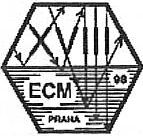


Regional news
The 18th European Crystallographic Meeting
Prague, Aug. 15-20, 1998

The meeting includes six parallel conferences on physical, technological, chemical and biochemical topics: Structure in Physics and Technology, Structure of Materials, Structural Aspects in Chemistry, Structure and Function of Biological Systems and Methods for Structure Determination, Advanced Methods for Structure Investigations, and General Discussions.
There will be eight microsymposia each containing up to seven lectures, two poster sessions, fourteen plenary lectures and several workshops. Written contributions will be published in the journal "Materials Structure in Chemistry, Biology, Physics and Technology". Selected review papers will be published in the "Post-Conference Book" intended to summarize the state of art in structure analysis at the beginning of new century.
50 years of the IUCr, 50 years of the journal Acta Crystallographica, 25 years of the European meetings on Crystallography and 650 years of the Charles University willl be celebrated.
Plenary lectures
Biological Applications (W. Hendrickson, New York, USA); Recent Development in Macromolecular Time-Resolved Crystallography (D. Bourgeois, France); Structural Aspects of Protein Synthesis (A. Liljas, Sweden); Chemistry and Evolution of the Catalytic Structures in Serine Hydrolases (G. Dodson, UK); Recognition and Repair of Mismatched Base-Pairs in DNA (L. Pearl, UK); Free-Electron Laser (G. Materlik, Germany); Inorganic Crystallography (V. Kaucic, Slovenija); The Structure and Dynamics of "Soft Matter" (J. White, Australia); Temperature, an Additional Dimension in Chemical Crystallography (H.-B. Buergi, Switzerland); Modulated and Aperiodic Structures (V. Petrícek, Czech Republic); In-situ Phase Transition Probed by Synchrotron Radiation (C. Landron, France); Real Structure of Surfaces and Interfaces (H. Fuess, Germany); Kinematical X-Ray Diffraction by Distorted Crystalline Materials, (P. Klimanek, Germany); History of the IUCr (D. Cruickshank, UK).
Microsymposia (Session Chairs in parenthesis)
Structure in Physics and Applied Crystallography
Spin, Charge & Momentum density (C. LeComte, France); Phase Transitions (L. Bohaty, Germany); Martensitic Phase Transformation (H. Morawiec, Poland); Defects and Microstructures (P. Klimanek, Germany); Texture and Stress Analysis (H.J. Bunge, Germany); Industrial Applications at Neutron and Synchrotron Sources (P. Scardi, Italy); Thin Films, Multilayers (H. Göbel, Germany); Epitaxial Thin Films, Surfaces (V. Holy, Czech Republic)
Materials Science
Structure of Minerals (S. Durovic, Slovakia); Structure Determination using Electron Diffraction (S. Hovmöller, Sweden); Nanocrystalline Materials (H.E. Schäffer, Germany); Crystallography Under Extreme Conditions (D. Häusermann, France); Optic, Electric and Magnetic Materials (J. Albertsson, Sweden); Small Angle Scattering (P. Laggner, Austria); Aperiodic Crystals and Quasicrystals (G. Chapuis, Switzerland); Low-Order and Non-cryst. Materials, Fibre Diffraction (J. Kroon, Netherlands).
Structural Aspects in Chemistry, Chemical Crystallography
Materials Chemistry - Reaction in Solids (W. Lengauer, Austria); Structure Systematics and Structure-Function Relations (U. Rychlewska, Poland); Crystal Growth in Physics, Chemistry and Technology (E. Scandale, Italy); Structure Determination by Powder Diffractometry (W.I. David, UK); Structure of Inorganic Compounds (R. Cerny, Switzerland); Molecular Modelling, Quantum Chemistry (S. Candeloro De Sanctis, Italy); Large Supramolecular Assemblies and Inclusion Compounds (G. Tsoucaris, France); Hydrogen Bonding (T. Steiner, Israel).
Structure and Function of Biological Systems
Transmission and Signalling Across Membranes (J. Drenth, Netherlands); Energetics of the Cell (N. W. Isaacs, UK); DNA/RNA - Structure, Binding Modes and Function (S. Neidle, U.K); Proteins and Drug Design (R. Pauptit, UK); Viruses, Anti-viral and Anti-retroviral treatment (L. Liljas, Sweden); Immunologically Active Molecules (G. Bentley, France); Protein biosynthesis. Transcription and Translation (A. Yonath, Israel); Metalloproteins - Structure and Function (P. Lindley, France).
Advanced Methods for Structure Determination in Biology
Synchrotron Radiation (A. Kvick, France); Neutron Scattering (C. Carlile, UK); Non-diffraction TechniquesG. Faigel, Hungary); Time Resolved Studies (M. Wulff, France); Ab Initio Methods (A. Podjarny, France); Accuracy and Validation of Macromolecular Structures (Z. Dauter, Germany); Molecular Replacement and Refinement (K. Wilson, UK); Multiple Anomalous Diffraction (G. Leonard, France).
General Crystallography and Discussion Meetings
Purification & Crystallization of Macromolecules (R. Hilgenfeld, Germany); INTERNET in Crystallography (A. Hewatt, France); Databases (F. Allen, UK); Structural Biology in Europe (A. Lewit-Bentley, France); Symmetry and Nomenclature (V. Kopsky, Czech Republic); Commercial lectures, Instruments (Z. Sourek, Czech Republic); Phase analysis (I. Madsen, Australia); Teaching Crystallography (A.Oskarsson, Sweden).
Organized by the Czech and Slovak Crystallographic Assn under the auspices of the IUCr, and European Crystallographic Assn and in cooperation with Fac. of Mathem. and Physics, Charles U., Fac. of Mech. Engineering, Czech Technical U., Inst. of Macromolecular Chemistry and Inst. of Physics of the Academy of Sciences of the Czech Republic, the Czech Engineering Academy and the National Museum.
Detailed information by WWW (http://kristal.karlov.mff.cuni.cz/ecm/ecm.htm) or Fax (004202 24911061).
Jindrich Hasek25 years of European Conferences
Joining Scientists in the Structure Analysis in Physics, Chemistry, Technology and Molecular Biology
The idea of holding joint European meetings for all scientists interested in methods of structure analysis applied in any field, ranging from the basic science to industrial or medical applications, began in Bordeaux, France 1973. Since then, these meetings have been held any year when the World Congress of IUCr did not take place. The focus of the meetings and the numbers of contributions from physics, chemistry and molecular biology has over the years changed. At the beginning, most contributions concerned development of methods and applications in the materials sciences and chemistry. Nowadays, the interests are divided equally between materials research (40%) and molecular biology (40%). The percentage of chemical sciences and applications has decreased to about 20%. This is reflected in the scientific program of the ECM-18 that is organized this year in Prague.


